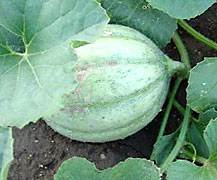


Home
Flowers &
Indoor Plants
Fruits & Nuts
Ornamentals
Vegetables
Special Topics
Resources
Glossary

|
Muskmelon cucumis melo (cue-cue-muss may-lo) 



Click on thumbnails for larger image. |
 |
What about it? Muskmelons are in the gourd family along with pumpkins, watermelons, and cucumbers. They are very similar to, but not the same as, the cantaloupe. Cantaloupes are preferred in Europe. Muskmelons have a 'netted' surface and sweet orange flesh. What is it used for? Muskmelons are a popular summertime fruit. Where does it grow? How do we grow it? Muskmelons are easier to grow than many people think. For sweet melons you will need plenty of sunshine, plenty of water, warm weather, and lots of room. The trick is to emend your growing season as much as possible. Ways to do this include: selecting early varieties, starting your seeds indoors, using black plastic mulch to keep the ground warm, and using plastic row covers to keep the heat in. Remember to take the covering off so that bees can pollinate the flowers when they bloom. Otherwise, you won't have any melon fruits. Also, plant the melons in the warmest part of your garden, usually a south-facing slope. The last two weeks before picking are crucial for producing sweet melons. Plants should get a great deal of heat and sunshine at this point. What are its primary problems? Muskmelons are attacked by cucumber beetles in their spare time (when they aren't bothering cucumbers). The squash vine borer may show up as well. Muskmelon might become plagued by anthracnose, bacterial wilt, viruses or powdery mildew. How do we propagate it? Start the seeds indoors for a jump on the warm weather. They require 3-4 months of 55-80 degree temperatures to ripen fully and sweetly. Set the transplants 2 feet apart after about 3 weeks. How do we harvest and store it? Ripe muskmelons will separate easily from the vine when picked. If you have to tug, the fruit is not ready to leave the garden. The rind will be tan between the surface netting. After harvesting, keep melons around 45 degrees F but do not refrigerate.
© Copyright, Department of Horticulture, Cornell University. |